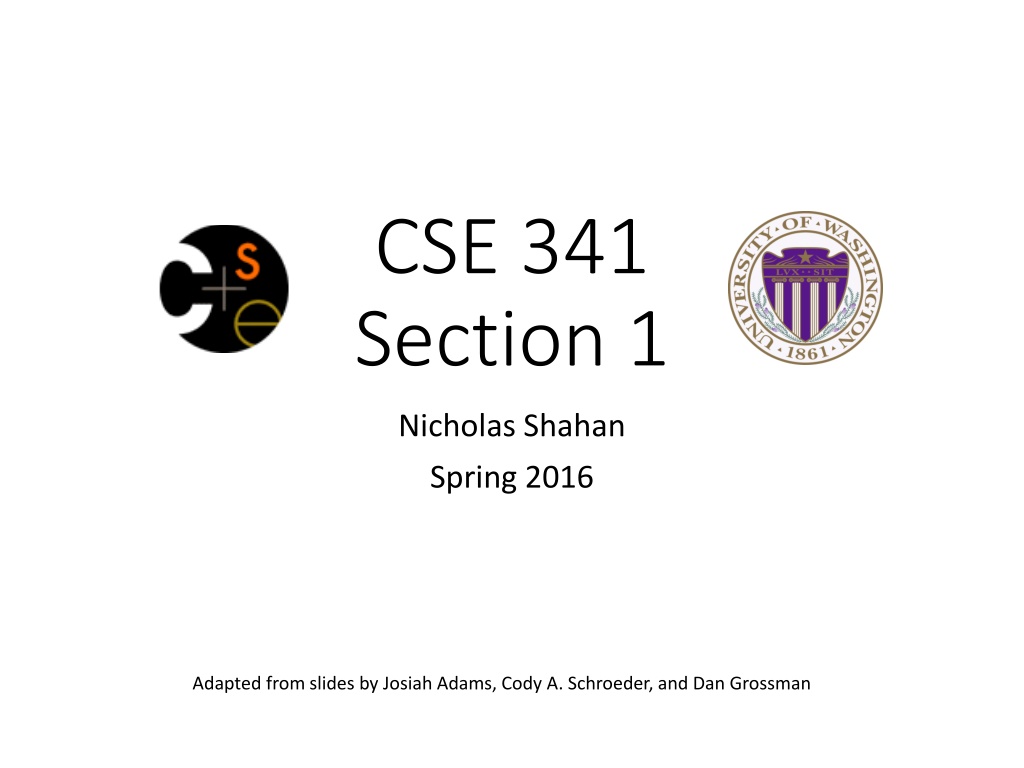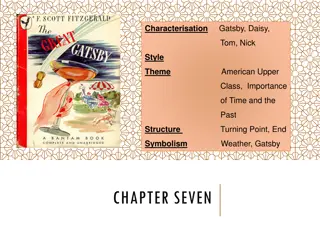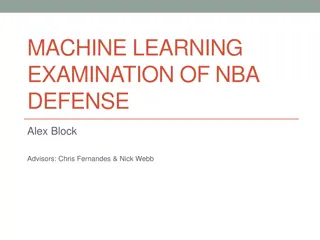
Understanding ML Development Workflow in CSE 341 Section 1
Explore ML development workflow in CSE 341 Section 1 with insights on Emacs, REPL, variable shadowing, and more. Learn about the efficient use of tools and techniques for effective programming in ML.
Download Presentation

Please find below an Image/Link to download the presentation.
The content on the website is provided AS IS for your information and personal use only. It may not be sold, licensed, or shared on other websites without obtaining consent from the author. If you encounter any issues during the download, it is possible that the publisher has removed the file from their server.
You are allowed to download the files provided on this website for personal or commercial use, subject to the condition that they are used lawfully. All files are the property of their respective owners.
The content on the website is provided AS IS for your information and personal use only. It may not be sold, licensed, or shared on other websites without obtaining consent from the author.
E N D
Presentation Transcript
CSE 341 Section 1 Nicholas Shahan Spring 2016 Adapted from slides by Josiah Adams, Cody A. Schroeder, and Dan Grossman
Hi, Im Nicholas orelse Nick 5th year Masters Student and THIS IS MY LAST QUARTER!!! Grew up in California Lived in San Francisco before moving to Seattle Talk to me any time about Movies, Music, Video Games Can also talk to me about CSE 341 2
Todays Agenda ML Development Workflow Emacs Using use The REPL More ML Shadowing Variables Debugging Tips Boolean Operations Comparison Operations 3
Emacs Recommended (not required) editor for this course Powerful, but the learning curve can at first be intimidating Helpful resources CSE 341 Emacs Guide Google it! /r/emacs Foot Pedals??? Course staff, or ask around in the labs 4
Quick Emacs Demo Image credit: http://earlcolour.deviantart.com/art/emacs-user-at-work-195326745 5
Using use use "foo.sml"; Enters bindings from the file foo.sml Like typing the variable bindings one at a time in sequential order into the REPL (more on this in a moment) Result is () bound to variable it Ignorable 6
The REPL Read-Eval-Print-Loop is well named Conveniently run programs: C-c C-s Useful to quickly try something out Save code for reuse by moving it into a persistent .sml file Expects semicolons For reasons discussed later, it s dangerous to reuse use without restarting the REPL session End the REPL session with C-d 7
Shadowing of Variable Bindings val a = 1; (* a -> 1 *) val b = a * 10; (* a -> 1, b -> 10 *) val a = 2; (* a -> 2, b -> 10 *) Expressions in variable bindings are evaluated eagerly Before the variable binding finishes Afterwards, the expression producing the value is irrelevant Multiple variable bindings to the same variable name, or shadowing , is allowed When looking up a variable, ML uses the most recent binding by that name in the current environment Remember, there is no way to assign to a variable in ML Can only shadow it in a later environment After binding, a variable s value is an immutable constant 8
Try to Avoid Shadowing val x = "Hello World"; val x = 2; (* is this a type error? *) val res = x * 2; (* is this 4 or a type error? *) Shadowing can be confusing and is often poor style Why? Reintroducing variable bindings in the same REPL session may.. make it seem like wrong code is correct; or make it seem like correct code is wrong. 9
Using a Shadowed Variable Is it ever possible to use a shadowed variable? Yes! And no It can be possible to uncover a shadowed variable when the latest binding goes out of scope val x = "Hello World"; fun add1(x : int) = x + 1; (* shadow x in func body *) val y = add1 2; val z = x ^ "!!"; (* "Hello World!!" *) 10
Use use Wisely Warning: Variable shadowing makes it dangerous to call use more than once without restarting the REPL session. It may be fine to repeatedly call use in the same REPL session, but unless you know what you re doing, be safe! Ex: loading multiple distinct files (with independent variable bindings) at the beginning of a session The behavior of use is well-defined, but even expert programmers can get confused Restart your REPL session before repeated calls to use 11
Debugging Errors Your mistake could be: Syntax: What you wrote means nothing or not the construct you intended Type-checking: What you wrote does not type-check Evaluation: It runs but produces wrong answer, or an exception, or an infinite loop Keep these straight when debugging even if sometimes one kind of mistake appears to be another 12
Play Around Best way to learn something: Try lots of things and don t be afraid of errors Work on developing resilience to mistakes Slow down Don t panic Read what you wrote very carefully Maybe watching me make a few mistakes will help 13
Boolean Operations Operation Syntax Type-checking Evaluation andalso e1andalsoe2 e1 and e2 must have type bool e1 and e2 must have type bool e1 must have type bool Same as Java s e1 && e2 orelse e1orelsee2 Same as Java s e1 || e2 not note1 Same as Java s !e1 not is just a pre-defined function, but andalso and orelse must be built-in operations since they cannot be implemented as a function in ML. Why? Because andalso and orelse short-circuit their evaluation and may not evaluate both e1 and e2. Be careful to always use andalso instead of and. and is completely different. We will get back to it later. 14
Style with Booleans Language does not needandalso , orelse , or not (* not e1 *) if e1 then false else true (* e1 andalso e2 *) if e1 then e2 else false (* e1 orelse e2 *) if e1 then true else e2 Using more concise forms generally much better style And definitely please do not do this: (* just say e (!!!) *) if e then true else false 15
Comparisons For comparing int values: = <> > < >= <= You might see weird error messages because comparators can be used with some other types too: > < >= <= can be used with real, but not a mixture of 1 int and 1 real = <> can be used with any equality type but not with real Let s not discuss equality types yet 16





















